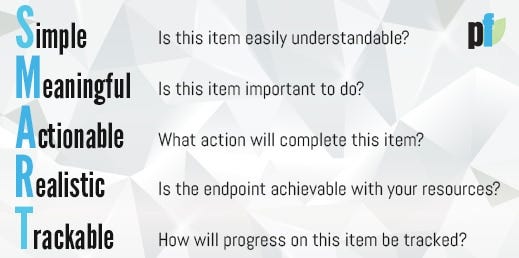What's the Real Goal Here?
Crafting the goal helps you see more clearly what the project really is.
Some time ago I shared about how I struggled with establishing a daily writing practice.
It was a goal I put on my monthly project list again and again but never seemed able to follow through on afterwards. Only after putting my goal (establish a daily writing practice) through PF’s version of SMART goals (Simple, Meaningful, Actionable, Realistic, Trackable) did I realize the goal itself was lacking in a few areas.
Specifically, it didn't feel meaningful.
And for me, meaning is the key that unlocks all other areas.
I embarked on a journey to uncover why this project kept showing up on my list. I wanted to understand its importance — since it would need to connect with both my mind and my heart.
When I searched for the “why” I kept coming back to this: I wanted to be able to share my ideas with the people who needed them — to share.
And while writing is one way to share, it’s definitely not the only one. By focusing on creating a daily writing practice, the emphasis had become all about me writing.
If I’m honest, it became about me-writing-perfectly-crafted-pieces, ready to publish immediately, because that’s how this works right?
It was a quest for perfection, not about my ideas or sharing them.
I had painted myself into a corner, which became clear after hearing Charlie’s advice: “Don’t make the how the goal because then you’ll get stuck.”
Helpful — but what should my project be instead, if not writing?
Sharing ideas with people who needed them sounded good in theory — until I went back to the rest of the SMART goal formulation and could see right away this new goal failed at ‘simple’: because I couldn’t tell you what I needed to do.
What became clear was I had to consider what was keeping me from sharing, to begin with.
The struggle wasn’t about a lack of ideas but about getting them out of my head. As soon as I went to reach for a device to capture a thought, I’d go blank. The ideas that usually flooded my brain dried up. Full stop. Hard to share ideas if you can’t capture them outside of your head.
Enter my new monthly goal:
Develop a coherent capture habit for my ideas.
This now nicely ladders up into a broader Quarterly goal around sharing:
Create a process for sharing my ideas with the people who need them.
Yes! At last, a goal that is SMART:
It’s simple. I know what I need to do, which is focus on capturing the ideas when they come — not concerning myself with how they should be formed.
It’s meaningful. I can’t help people if I can’t articulate my thoughts. I can articulate them and get them out in the world if I can get them down on paper.
It’s actionable. It will require testing different tools and methods to find out what works for me — but that’s doable.
It’s realistic. Thanks to suggestions from the PF community, I have a few tools and methods to test out. Now all I need to do is wait for the ideas to come (and that has never been my problem).
It’s trackable. It’s easy to track the number of ideas and types of ideas. I can even track idea patterns by noting down when and where the idea came from. This last bit will be helpful the next time I find myself in a rut and need a creativity jumpstart.
SMART goals can help you prioritize, implement, and get moving on a project. And as I found, crafting that goal can sometimes help you see more clearly what the project is really about.
Now that I can see where I want to go, I can focus my attention on the methods I might use to get me there.
For this, I’ll need to use my GATES. But that’s another column.
This post was originally published May 26, 2022.
Check out the Start Finishing Field Guide, which includes exercises to help you convert your idea into a project — including crafting SMART goals.






